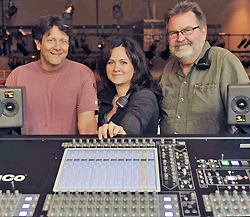The Alison Krauss & Union Station tour this year in support of the band’s new album, Paper Airplanes, brings a tightly knit fusion of bluegrass and country to fans old and new.
Taking charge of the tour’s production is longtime audio frontman Cliff Miller of North Carolina’s SE Systems. Last summer, Miller put a pair of newly minted DiGiCo SD10 consoles through their paces at the 2010 MerleFest, one of the country’s premier Americana and roots music festivals.
Based on that experience, Miller decided to entrust the Union Station tour to DiGiCo, placing the consoles at front of house and monitors for himself, daughter Haley (Krauss monitors), and Bernie Velluti (band monitors).
The nightly challenge of presenting acoustic music in venues ranging from indoor auditoriums to outdoor sheds isn’t lost on Miller, who’s been at it for over 40 years, working with some of the most prominent artists of the genre. He says the SD10 has been a key component on this tour, showcasing the nuances of the band’s sound.
“The console is so amazingly consistent and I’m very pleased with the clean quality of sound we’re getting out of it,” Miller says. “Mixing an acoustic band like this is probably one of the more challenging things for a digital console… it’s really the sum of all the parts and what goes into the console that affects what comes out. There’s a lot of detail with stringed instruments that you never hear with electric guitars and a lot of the other typical rock ‘n’ roll instruments.
“It’s important to understand the sound of these instruments because when they’re amplified, it’s literally a balancing act to get that right blend—where the sound system is equalized and isolated enough to keep the instrument resonance minimal and as natural as possible, and the low-end frequencies maintained,” he continues. “And that can change, too, depending on the facility and whether it’s indoor versus outdoors. Outdoor sheds with vinyl roofs over the audience are a real challenge. There’s a lot of reflection even when you make a point of keeping the PA out of it. It’s very live.
“I find that even in the varying circumstances, once I get the overall PA tuned the way it needs to be, then my presets work well from day to day, inside or outside, pretty consistently. The only thing that may change is the EQ from day to day. Sometimes Ron [Block; banjo/guitar] may change the EQ on his Fishman Aura DI, depending on what he’s hearing in his ears. That affects what I’m getting at front of house, so I just compensate for that on a daily basis. I let him get it to suit his taste and then I set it to suit mine.”
In addition to the pair of SD10s, Miller’s carrying two DiGiCo SD-Racks, with one serving as an emergency spare, citing their warm, analog preamp sound.
The outboard gear is non-existent with the exception of a Lake LM 26 processor. “The way I’m inserting the Lake processor—which is digitally inserted using the AES sends and returns for my mains, front and side fills—I’m driving it with matrix outputs to the input of the delay. But on the returns, I have three stereo aux sends set up so its coming into the insert IN, so the biamped output of my Lake for my front and side fills and my stereo subwoofers are all being sent from stereo aux sends,” Miller explains.
“Having the insert features is really handy on the console for driving multiple lines and getting signals. Depending on the venue, and if we’re using an in-house sound system, I’ll send all the sends off the console to analog outputs, if that’s where their inputs are. Otherwise, I can send them from the SD Rack on the stage. It’s very versatile, easy to route outputs, and you can rename them for whatever you need. You always have enough.
“And I really love having those two-two spaces on the SD-Rack underneath for a total of 4 rack spaces. On one side I have a UPS just as a backup in case we lose power, and on the other side, I have the Lake processor, a spare USB pre for my Smaart rig [the Rational Acoustics’ equalization software], and a receiver for a TM400 Lectrosonics test and measurement microphone. There’s not an outboard rack, you just set up the console, plug it in, and I’m ready to go.”




















